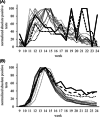Retarded decline of the share of SARS-CoV-2-positive children in North Rhine-Westphalia, Germany
- PMID: 32986242
- PMCID: PMC7537067
- DOI: 10.1002/jmv.26564
Retarded decline of the share of SARS-CoV-2-positive children in North Rhine-Westphalia, Germany
Abstract
Knowledge on the mechanisms of viral spread, of time-related changes, and age-specific factors of severe acute respiratory syndrome coronavirus 2 infections is important to develop recommendations aimed at controlling the pandemic. In this context, longitudinal data on proportions of positive results in different age groups are rare. Data on total positive counts and on shares of positive counts deriving from a private (MVZ) and a University (RWTH) laboratory were analyzed retrospectively and compared with public data on total positive counts of the Robert Koch Institute (RKI). Data were covered for Weeks 9-24 of the year 2020 and all patient ages. Total positive counts were lower in children compared to adults. Proportions of children and adults tested positive were 3%-5% and 5%-7%, respectively. RKI and MVZ data showed similar time-related patterns. Patients of 20-60 years of age did account for the initial virus spread (maximum infection rates at Weeks 9-11). Thereafter, infection rates decreased in older patients whereas children did not show a comparable time-related decrease. Pediatric data generated in outpatient settings and hospitals differed markedly which should be considered in further studies. In summary, compared with adults children are less affected by severe acute respiratory syndrome coronavirus 2 infections and are unlikely to account for the initial viral spread. However, children show sustained viral activity and may serve as a viral reservoir.
Keywords: COVID-2019; SARS-CoV-2; children; epidemiology; viral reservoir; virus spread.
© 2020 The Authors. Journal of Medical Virology published by Wiley Periodicals LLC.
Conflict of interest statement
The authors declare that there are no conflict of interests.
Figures




References
MeSH terms
LinkOut - more resources
Full Text Sources
Medical
Miscellaneous

